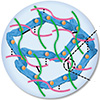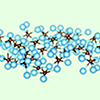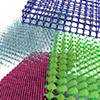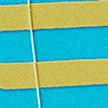Showing Spotlights 41 - 48 of 338 in category All (newest first):
 Exploring the recent advancements in conductive hydrogel-based epidermic sensors for wearable healthcare and human-machine interaction, researchers created and applied a new MXene hydrogel with enhanced mechanical strength, improved electrical conductivity, and antibacterial properties.
Exploring the recent advancements in conductive hydrogel-based epidermic sensors for wearable healthcare and human-machine interaction, researchers created and applied a new MXene hydrogel with enhanced mechanical strength, improved electrical conductivity, and antibacterial properties.
May 18th, 2023
 Scientists have recently discovered a new class of amorphous nanomaterials that are created by introducing atomic irregular arrangements. These materials demonstrate excellent performance in catalysis, energy storage, and mechanics.
Scientists have recently discovered a new class of amorphous nanomaterials that are created by introducing atomic irregular arrangements. These materials demonstrate excellent performance in catalysis, energy storage, and mechanics.
May 9th, 2023
 Researchers have reviewed recent advances of heterogeneous integration of van der Waals materials from 2D materials to functional 3D crystalline nanomembranes for advanced photonic and optoelectronic applications.
Researchers have reviewed recent advances of heterogeneous integration of van der Waals materials from 2D materials to functional 3D crystalline nanomembranes for advanced photonic and optoelectronic applications.
Apr 21st, 2023
 Our society generates staggering amounts of waste in all areas of economic activities. Foremost among them, apart from energy waste, are the food and plastic sectors. However, both food and plastic wastes are potentially valuable sources of carbon. are working on upcycling of waste materials to high-value carbon by combining materials science and nanotechnology approaches to develop functional nanostructures for advanced energy storage, catalysis, water purification, and biosensor applications.
Our society generates staggering amounts of waste in all areas of economic activities. Foremost among them, apart from energy waste, are the food and plastic sectors. However, both food and plastic wastes are potentially valuable sources of carbon. are working on upcycling of waste materials to high-value carbon by combining materials science and nanotechnology approaches to develop functional nanostructures for advanced energy storage, catalysis, water purification, and biosensor applications.
Feb 21st, 2023
 A new motorized three-point-bending apparatus has been developed that is capable of automating strain engineering experiments on two-dimensional (2D) materials. The setup can be used to apply precise, uniform strain to 2D materials such as MoS2, allowing researchers to study the effects of strain on the electrical and optical properties of these materials. The system can also be used to study straintronic devices, devices whose output characteristics can be adjusted by means of applied strain.
A new motorized three-point-bending apparatus has been developed that is capable of automating strain engineering experiments on two-dimensional (2D) materials. The setup can be used to apply precise, uniform strain to 2D materials such as MoS2, allowing researchers to study the effects of strain on the electrical and optical properties of these materials. The system can also be used to study straintronic devices, devices whose output characteristics can be adjusted by means of applied strain.
Dec 16th, 2022
 Magnetism at atomically thin two-dimensional (2D) materials is of essential interest to scientists and engineers since it has the potential to revolutionize modern information technology enabling ultra-fast and ultra-small novel electronic and magnetic devices. However, most of the experimentally demonstrated 2D magnets possess a Curie point far below the room temperature, limiting their application in the real world. In new work, researchers developed an end-to-end computational pipeline that can predict the Curie temperature accurately from the first principles-based quantum mechanical calculations.
Magnetism at atomically thin two-dimensional (2D) materials is of essential interest to scientists and engineers since it has the potential to revolutionize modern information technology enabling ultra-fast and ultra-small novel electronic and magnetic devices. However, most of the experimentally demonstrated 2D magnets possess a Curie point far below the room temperature, limiting their application in the real world. In new work, researchers developed an end-to-end computational pipeline that can predict the Curie temperature accurately from the first principles-based quantum mechanical calculations.
Dec 12th, 2022
 Recent investigations suggest that topological semimetals reveal unique properties that can enable unprecedented functionalities for future electronics. New research results shed light on the specifics of electron transport in quasi-one-dimensional topological Weyl semimetals and can be important for their proposed applications as downscaled interconnects. The results obtained in this work can be used for developing assessment methodologies for the reliability of topological semimetals.
Recent investigations suggest that topological semimetals reveal unique properties that can enable unprecedented functionalities for future electronics. New research results shed light on the specifics of electron transport in quasi-one-dimensional topological Weyl semimetals and can be important for their proposed applications as downscaled interconnects. The results obtained in this work can be used for developing assessment methodologies for the reliability of topological semimetals.
Nov 22nd, 2022
 The discovery of magnetism in two-dimensional (2D) ultrathin crystals opens up opportunities to explore new physics and to develop next-generation spintronic devices. However, 2D magnetic semiconductors with Curie temperatures higher than room temperature have rarely been reported. Researchers now show that high-quality, nonlayered cobalt ferrite nanosheets as thin as a single unit cell can be synthesized via van der Waals epitaxy.
The discovery of magnetism in two-dimensional (2D) ultrathin crystals opens up opportunities to explore new physics and to develop next-generation spintronic devices. However, 2D magnetic semiconductors with Curie temperatures higher than room temperature have rarely been reported. Researchers now show that high-quality, nonlayered cobalt ferrite nanosheets as thin as a single unit cell can be synthesized via van der Waals epitaxy.
Nov 15th, 2022
 Exploring the recent advancements in conductive hydrogel-based epidermic sensors for wearable healthcare and human-machine interaction, researchers created and applied a new MXene hydrogel with enhanced mechanical strength, improved electrical conductivity, and antibacterial properties.
Exploring the recent advancements in conductive hydrogel-based epidermic sensors for wearable healthcare and human-machine interaction, researchers created and applied a new MXene hydrogel with enhanced mechanical strength, improved electrical conductivity, and antibacterial properties.
 Subscribe to our Nanotechnology Spotlight feed
Subscribe to our Nanotechnology Spotlight feed





